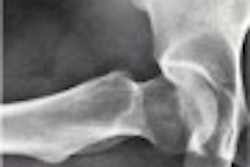
AuntMinnie.com is pleased to present Part I of a four-part white paper on pediatric imaging tips and techniques by Douglas Clark, R.T. (R) (CT).
No matter how many years I’ve plied my profession, or how long I’ve been a parent, working with sick or injured children and their families can always pose unique challenges. When I was in radiography school, I was given classes in pediatric radiography and patient care and was told to read countless pages on the subjects.
But after graduation I quickly found that college was a whole lot different than real life. Those cooperative children and their parents that I had read about and positioned in the mock x-ray labs weren’t the same ones I was seeing in the hospitals and clinics. In short, I found that I really didn’t know it all, and that I needed to create a whole new bag of tricks.
Education provided book knowledge and a good foundation, but it is experience that provided the learning scenarios that transformed me from button pusher to technologist. The pitfalls and pearls in this paper are gleaned from being a practicing technologist in both diagnostic radiography and CT, talking with other technologists about their special techniques, and working with knowledgeable radiologists who’ve helped me build my foundation over the years.
Most of the topics and ideas I’ll be covering aren’t set in stone. However, they have been proven over the years, and they certainly will give you a point of reference in the challenges of imaging the pediatric patient.
Demographics
Whether we work in the emergency department (ED) of our local hospital or a little doc-in-the-box, we’re bound to handle challenging pediatric imaging cases. The American College of Emergency Physicians estimates that there are over 31 million children and adolescents seen in EDs in the U.S. every year, and of these, over 13 million are injury-related.
In 1995 the American Academy of Pediatrics Committee on Emergency Medicine designated guidelines "for the administration and coordination in the ED for care of children" due to the increase in pediatric patients being seen.
The U.S. Centers for Disease Control (CDC) states that unintentional injuries are the number one cause of death in children between 1 and 21 years of age. They also estimate that for each death there are on average 1,000 patients seen and 34 admissions.
There are three common areas of injury for children: at home (44%), at school (19%), and after school (37%).
At-home injuries include:
- Water-related -- kitchen, bath, or pool
- Heat-related -- kitchen or barbecue
- High-energy -- falls down stairs or guns
School-related injuries include:
- Sports and/or lack of proper equipment
- Weapons
After-school injuries include:
- Motor vehicle collisions (MVC)
- Bicycle mishaps
- Motor vehicle versus pedestrian incidents (MVP)
The CDC lists causes for ED visits in children and their expected injury patterns as:
- MVC -- both blunt and head trauma
- Sports -- both blunt and head trauma
- Burns -- body thermal injury and inhalation injury
- Drowning -- coma and brain injury
- Falls -- traumatic brain injury (TBI) (children less than or at 5 years old are prone to head injury due to their larger head size), blunt trauma, and fractures (fxs)
- Poisoning -- coma, renal failure
Psychological factors
Any time we listen to a radiology lecture about children, we seem to hear experts talking at length about age-based concerns. Still, it’s important to remember that just because a child is a certain age chronologically, it doesn’t mean that mentally he or she is at the same level.
Often we will get a youngster of eight or nine years who is as intelligent as a teenager. At the same time I’m reminded of a college coed freshman that presented in short shorts and a crop top -- but held onto her Beanie-baby throughout her entire ED stay.
So as you approach your patient, be it an ED or outpatient, slow down and take the time to look and listen, considering both their chronological age and also how they respond to you in terms of comprehension.
On a very basic level, let's talk about children’s fears and needs at various ages.
Infants need warmth, as they get hypothermic very quickly. Be conscious of the temperature of your room and how long you keep the infant unwrapped or undressed. Neonates lose much of their body heat through their head, so if they come in with a stocking cap on and it doesn’t interfere with your images, keep it on.
They fear separation from familiar surroundings, sights, and smells, such as their parents or grandparents. You'll have to decide, on a case-by-case basis, if it's better or easier to have the family in the room while you image the infant or if they should wait outside. If the family does come in the room, make sure they’re given a lead apron.
Children (1-10 years or so) have a longer list of concerns. They tend to frighten easily, may be afraid of the dark, the unknown, and being alone. They are also becoming more aware of their bodies so privacy is an issue to be addressed as well.
Children in this age group tend to be more curious, so explanations are a good thing. Praise for a good job or cooperation is a great reinforcement tool as well.
Adolescents expect honest explanations. They also fear a loss of control of their bodies and their environment. Despite varied emotional and physical development, they uniformly express a strong need for privacy.
No matter what your patient’s age is, be honest. Don't tell them that manipulating a fractured extremity won’t be painful -- it will. Don’t say they won’t feel a thing from the IV contrast injection. Honesty goes a long way in ensuring patient cooperation.
Patient communication and parental interaction
As you're wheeling your ED patient into the CT room, you might come upon some of the other techs and attendants commenting on last night's department party. There they are, bantering back and forth and laughing about one of the more memorable moments in the evening's festivities.
Certainly, positive morale and communication in the department are good things. But what the patient hears and perceives is a group of people talking and laughing at him or, at the very least, not concentrating fully on his care. Can you see how such an impression might spiral out of control?
As you approach your patient, whether they're from the ED or an outpatient referral, take a moment and a deep breath. Patients and add-on requests may have slammed you that morning, and as you move to that next patient your tone is harried and rushed. Slow down.
There's always going to be that next patient, because we can only do one at a time. Does it make more sense to rush through the exam and have to repeat it because you didn’t position the patient anatomically correctly or you didn’t scan far enough through a body part? Mistakes happen. It’s important that we realize this, and do what we can to avoid errors.
Watch your language when you talk to your patients. I don't mean inappropriate or offensive language. I mean using simple, honest words to make a point and ensure that your patient understands what you expect of them and what's going to happen to them.
Cooperation makes our jobs so much easier. Watch out for words or phrases that have a double meaning such as: "I just have to take one more shot" or "We're going to give you some dye." People and children may take those words at face value.
Also, when you're talking to your patients, take their education level into account as well. When I was a student, I was mortified to see one of my preceptors give a patient a urinal and ask him to "go in the other room and pee in this, please." The patient was fine with it and did what was asked. What I didn’t know at the time was that the preceptor had tried to define "make water," "number 1," and "urinate," much to the patient's confusion. But when she used a more down-to-earth term, the patient understood completely.
Allow the use of a safety net. What is it that makes the child more comfortable? Does having mom or dad there make the situation better or worse? Is the child more comfortable holding on to a stuffed animal or a Barbie doll?
I’ve scanned more Barneys and Blues Clues characters over the years than I care to remember. Does their blankie help them to cope with their fear? If it doesn’t interfere with the imaging -- let them have it.
You might want to reacquaint yourself with some of the more popular children’s shows on TV nowadays. Do the names Sponge Bob, Patrick, Dora the Explorer, or Boots mean anything to you? Sometimes getting the child conversing about something they're knowledgeable about makes them more comfortable, and makes your job easier.
Another pearl that works at times is music. We had a little girl who fell out of a pick-up truck and struck her head. She was altered, combative, and we had to try to get a brain CT on her to assess the extent of her injury.
We couldn't give any sedation because of the head injury, so we tried mom and dad in the room. We tried grandma and grandpa and we tried blankie and Baby Bop. Nothing worked.
At some point my gaze fell on the CD player in the back of the room, and one of the docs threw on a James Taylor CD that I had there. After one verse of Fire and Rain she calmed down enough to scan her. We laughed afterwards but our pediatric ED stocked itself with cassette players shortly after that, and we got children's tapes from the resale shops in the area.
Children present some unique challenges in terms of imaging, whether in diagnostic radiography or CT. We have to ensure their cooperation and try to quell their fears. We have to be able to achieve adequate positioning (though nothing will ever look like it did in Bontrager) to get quality images.
Who holds your patient -- you or the parent? This is a rhetorical question, and the answer is, whichever works better.
Children breathe more rapidly than adults, so catching that chest x-ray on a full inspiration might be harder than it looks. How much artifact and misregistration will we be looking at if we try to CT a child who's crying or flailing about?
By Douglas ClarkAuntMinnnie.com contributing writer
April 22, 2004
Join us Monday for Imaging the pediatric patient, Part II: diagnostic radiography
Douglas Clark is a staff CT technologist with University Health System in San Antonio, and has been a radiologic technologist since 1990.
Bibliography
U.S. Centers for Disease Control, Pediatric Injury Prevention Guidelines, 1999.
Related Reading
Misread scans often lead to osteoporosis diagnosis in children, March 22, 2004
PET/CT brings added value to pediatric oncology, February 27, 2004
Ultrasound, CT, or MRI best for pediatric foot toothpick puncture injuries, February 25, 2004
Bladder shape affects pediatric ultrasound bladder-volume estimates, August 29, 2003
Radiologists offer new guidance on reducing CT radiation dose, August 14, 2003
Copyright © 2004 Douglas Clark



















